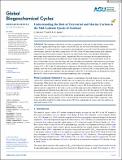Understanding the role of terrestrial and marine carbon in the mid-latitude fjords of Scotland
Abstract
The sediments within fjords are critical components of the mid- to high-latitude coastal carbon (C) cycle, trapping and storing more organic carbon (OC) per unit area than other marine sedimentary environments. Located at the land-ocean transition, fjord sediments receive OC from both marine and terrestrial environments; globally, it has been estimated that 55% to 62% of the OC held within modern fjord sediments originates from terrestrial environments. However, the mid-latitude fjords of the Northern Hemisphere have largely been omitted from these global compilations. Here we investigate the mechanism driving the distribution of OC originating from different sources within the sediments of 38 Scottish fjords. From an array of fjord characteristics, the tidal range and outer sill depth were identified as the main drivers governing the proportions of marine and terrestrial OC in the sediments. Utilizing this relationship, we estimate that on average 52 ± 10% of the OC held within the sediments of all Scotland’s fjords is terrestrial in origin. These findings show that the Scottish fjords hold equivalent quantities of terrestrial OC as other global fjord systems. However, the analysis also highlights that the sediments within 29 % of Scottish fjords are dominated by marine derived OC, which is driven by local fjord geomorphology and oceanography.
Citation
Smeaton , C & Austin , W 2022 , ' Understanding the role of terrestrial and marine carbon in the mid-latitude fjords of Scotland ' , Global Biogeochemical Cycles , vol. 36 , no. 11 , e2022GB007434 . https://doi.org/10.1029/2022GB007434
Publication
Global Biogeochemical Cycles
Status
Peer reviewed
ISSN
0886-6236Type
Journal article
Description
This work was supported by the Scottish Blue Carbon Forum. Additional, sample collection was supported by the Biotechnology and Biological Sciences Research Council (BBSRC) and the manuscript submitted to Global Biogeochemical Cycles Natural Environment Research Council (NERC) (BB/M026620/01). NERC also supported the analysis within this project through the NERC Life Science Mass Spectrometry Facility (CEH_L_098_11_2015 and CEH_L-155-05-2018).Collections
Items in the St Andrews Research Repository are protected by copyright, with all rights reserved, unless otherwise indicated.

